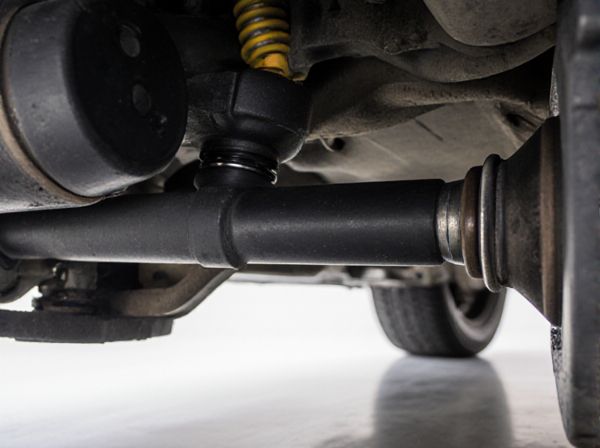
Photo illustration: Driven Axle vs Non-Driven Axle
A driven axle transmits power from the engine to the wheels, providing movement and traction, while a non-driven axle supports the vehicle's weight without propelling it. Your vehicle's performance, fuel efficiency, and handling are influenced by whether the axle is driven or non-driven. Understanding these differences helps in selecting the right type of axle for specific applications and vehicle requirements.
Table of Comparison
| Feature | Driven Axle | Non-Driven Axle |
|---|---|---|
| Function | Transfers engine power to wheels | Supports vehicle weight, no power transfer |
| Location | Linked to drivetrain (front or rear) | Not connected to drivetrain |
| Components | Includes differential, drive shafts | Simple axle, bearings only |
| Purpose | Provides traction and propulsion | Maintains vehicle stability and load support |
| Examples | Rear axle in rear-wheel drive cars | Front axle in rear-wheel drive cars |
Introduction to Driven and Non-Driven Axles
Driven axles transmit engine power to the wheels, enabling vehicle movement and providing traction, while non-driven axles support the vehicle's weight and allow wheels to rotate freely without receiving power. Commonly found in front-wheel-drive, rear-wheel-drive, and all-wheel-drive systems, driven axles are integral for propulsion and control. Non-driven axles primarily function in maintaining stability and load distribution, contributing to overall vehicle performance without directly influencing acceleration.
Definition: What is a Driven Axle?
A driven axle is a key component in a vehicle's drivetrain that receives power directly from the engine or motor to turn the wheels and propel the vehicle forward. It is connected to the transmission or differential, enabling torque transfer necessary for movement. Unlike non-driven axles, driven axles actively contribute to vehicle motion by transmitting mechanical power.
Definition: What is a Non-Driven Axle?
A non-driven axle, also known as a passive or idler axle, is an axle that supports the vehicle's weight without transmitting engine power to the wheels. Unlike driven axles, non-driven axles do not receive torque from the drivetrain and serve primarily for load-bearing and stability purposes. Commonly found in trailers and some multi-axle trucks, non-driven axles help distribute weight evenly and improve road handling.
Key Differences Between Driven and Non-Driven Axles
Driven axles transmit engine power to the wheels, enabling vehicle movement, while non-driven axles primarily support the vehicle's weight without delivering power. Driven axles are typically found in front-wheel, rear-wheel, or all-wheel-drive systems and include components like the differential and driveshaft. Non-driven axles serve as load-bearing and steering mechanisms, often seen in trailers and certain vehicle configurations without power delivery.
Applications of Driven Axles in Vehicles
Driven axles transmit torque from the engine to the wheels, providing vehicle propulsion essential for applications in trucks, SUVs, and performance cars that require enhanced traction and load-carrying capacity. These axles are critical in off-road and heavy-duty vehicles where power delivery to all wheels improves stability and control on challenging terrains. In contrast, non-driven axles primarily support vehicle weight and allow wheel rotation without power transmission, commonly found in trailers and unpowered wheel sets.
Applications of Non-Driven Axles in Vehicles
Non-driven axles in vehicles primarily serve as support and load-bearing components without delivering power from the engine, commonly found in trailer axles or rear axles of front-wheel-drive cars. These axles enhance vehicle stability and weight distribution, crucial in trucks, trailers, and passenger cars for improved ride quality and handling. Non-driven axles reduce drivetrain complexity and maintenance needs, making them essential in applications focused on efficiency and durability rather than propulsion.
Advantages of Driven Axles
Driven axles provide enhanced traction by transmitting engine power directly to the wheels, improving vehicle performance on rough or slippery surfaces. They contribute to better load distribution and stability, especially in heavy-duty vehicles and off-road conditions. This results in increased efficiency, reduced wheel slip, and improved overall control.
Advantages of Non-Driven Axles
Non-driven axles offer advantages such as reduced mechanical complexity and lower maintenance requirements since they do not transfer engine power. These axles contribute to increased fuel efficiency by minimizing energy loss during vehicle operation. Their simpler design also results in lighter axle assemblies, enhancing vehicle payload capacity and overall performance.
Driven Axle vs Non-Driven Axle: Which is Better?
Driven axles transmit engine power directly to the wheels, providing better traction and control, especially in off-road or slippery conditions, while non-driven axles support vehicle weight without delivering power. Choosing between driven and non-driven axles depends on vehicle purpose: driven axles enhance performance and handling in demanding terrains, whereas non-driven axles offer simplicity and lower maintenance for standard driving. For applications requiring superior traction and power distribution, driven axles are generally better, while non-driven axles suit lighter-duty and fuel-efficient vehicles.
Conclusion: Choosing the Right Axle Type
Selecting the right axle type depends on vehicle function and terrain conditions; driven axles provide power to wheels ensuring traction and control, essential for off-road and heavy-duty applications. Non-driven axles support vehicle weight without transmitting power, suitable for trailers and lighter loads. Understanding load requirements, drivetrain configuration, and operational environment optimizes performance and durability in axle selection.
 caratoz.com
caratoz.com